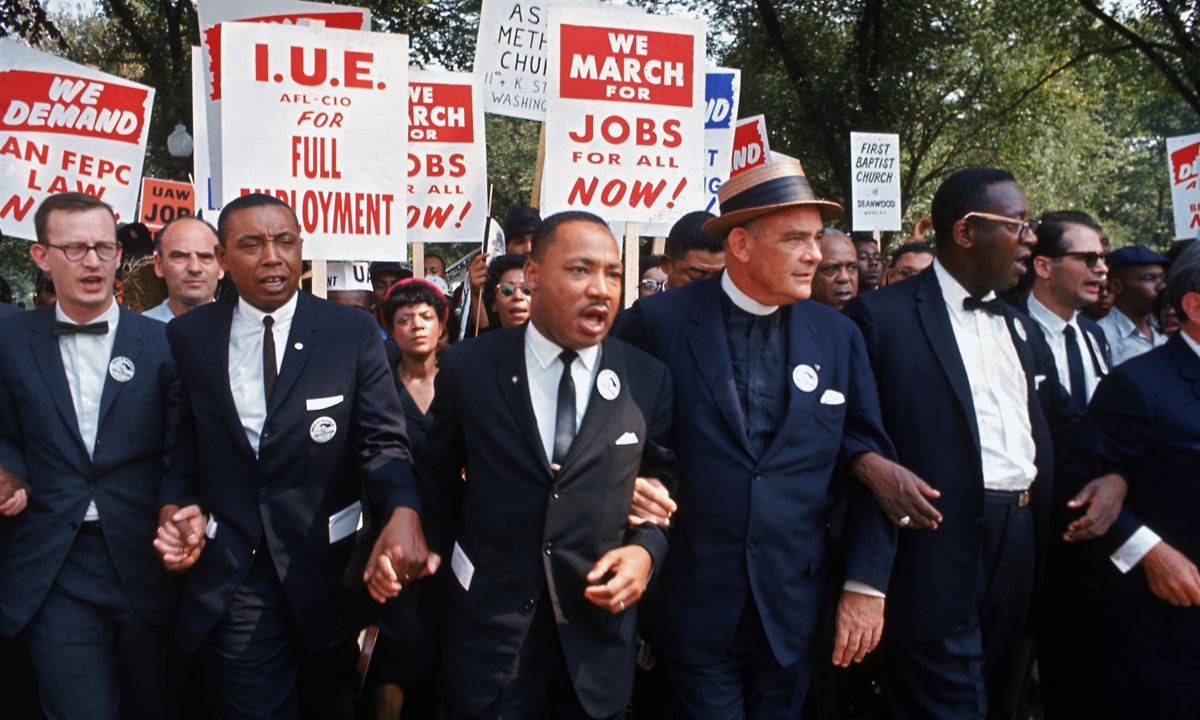
Leaders of March on Washington for Jobs & Freedom marching with signs. Left to right: Matthew Ahmann, Floyd McKissick Jr., Martin Luther King Jr., Eugene Carson Blake and Cleveland Robinson. (Photo by Robert W. Kelley/The LIFE Picture Collection/Getty Images)
Donald Trump and his supporters may be waging battles against the press, immigrants, voting rights, the environment, science, social welfare programs, Planned Parenthood and what they label political correctness and the deep state.
But to them these are mere skirmishes in a much larger conflict. The president has essentially declared an all-out war on the American 1960s.
What he and his followers hope to do is not necessarily turn back the clock to the 1950s, but rather restore a social order, value system and “real America” that they believe was hijacked by the liberal culture, politics, thought leaders and policy priorities that emerged from the ’60s.
An October 2016 PRRI survey found close to three-fourths of Trump voters and white evangelical Christians bemoaning an American society and way of life that to them has changed for the worse since the 1950s. Donald Trump has become their cultural and political reset button.
To be sure, no immigration policy or insistence on saying Merry Christmas will reinstate the 1950s in America. A nation that was 87 percent non-Hispanic white in 1950 will be 47 percent in 2050. Seven in 10 Americans claimed church membership during the ’50s, but now just 20 percent of millennials say churchgoing is important and almost 40 percent say they have no religious affiliation at all.
But while the president and his supporters can’t reverse demography, they are trying through rhetoric, symbolism, policy and politics to resurrect an iconic post-World War II Norman Rockwell version of what it means to be authentically American.
To them, the ’60s undermined what was good and virtuous in America. In their sepia-toned view of our history, it was a triumphant military, a white working class and a Father Knows Best conception of nuclear families, moral values and suburban bliss that made America great.
In this America we saluted the flag, revered the police, attended church, trusted authority, respected tradition and venerated sturdy, stoic, upstanding lunch pail heroes who earned their American dream without griping or government assistance.
It’s not that religious and ethnic minorities are absent from this history — they gave America character, after all and we all need to show our melting pot tolerance. But how nice it was that they knew their place, didn’t get too uppity and honored the primacy of Christians and whites who, the story goes, steadied and built the United States.
America was much more of a community before the agitators caused all the problems, wasn’t it?
Then came the 1960s. And it was then that the so-called agitators pointed out that those charming Levittown havens — just like the Trump apartment complexes — had no welcome mat for blacks and those good middle-class occupations excluded women.
It was a generation that questioned God, fled the church, disparaged conformity, upended gender roles, asserted black power and criticized the military for Vietnam and the police for brutalizing civil rights workers, killing African-Americans and bullying antiwar protesters.
It also was a singular moment in our history that codified into law personal privacy rights and a woman’s right to control her own fate. It would begin our long cultural march to rethink masculinity and lift the taboo from same sex relations. It also launched an environmental movement that said yes to the Earth and no to the smokestack.
In the ’60s our moral compass pivoted from judgmental scrutiny of our private lives to an examination of our collective and individual capacity for prejudice, bigotry and discrimination. Minorities, previously considered America’s outliers, became central to our historical narrative. We passed civil rights and immigration laws that changed the complexion of mainstream America and who showed up to vote. White men would no longer control America’s storyline.
For many, the ’60s redefined patriotism away from flag waving and military might to the pursuit of equality and justice for all. It was an era that celebrated an unbowed press for rooting out corruption, uncovering secrets and pointing out where our democracy had fallen short.
Whereas the 1950s sanctified unfettered capitalism as a rebuke to communism and symbol of freedom, in the 1960s many began to eye it with a new skepticism as corporations pumped pollution into rivers and produced cars unsafe at any speed. The economic and cultural fulcrum also began its shift from the factory floor to the college campus and with it came the realization that brains and not brawn would define our future and build a stronger America.
The ’60s also challenged a shibboleth of the ’50s: that if you worked hard you could succeed, but if you didn’t succeed it was because you didn’t work hard. Liberals led by Martin Luther King Jr. and Lyndon Johnson argued that even the hardest of work didn’t free millions from the chains of history, and so they turned to government to level the playing field and cushion the hard blows of misfortune.
To many white men who saw their own sweat and labor yield suburban happiness and middle-class fruits — and seemingly unconcerned that the same opportunities weren’t available to all — government elites were creating a protected class at their expense.
The ’60s bent the river of American history and now Donald Trump and his own “silent majority” are doing everything in their power to bend it back.
On immigration, race, voting rights, women’s rights, religion, cultural issues, public schools, higher education, social programs, business, labor, coal, the environment, the news media, the white working class, the military and the police, virtually all of his policies, pronouncements and tweets are aimed at restoring what Steve Bannon has called the “very kind of 1950s values” that made America great.
Perhaps that is what President Trump meant in his July 2017 speech in Warsaw, Poland, when he dedicated his presidency “to counter forces … that threaten over time to undermine these values and to erase the bonds of culture, faith and tradition that make us who we are.”
It’s often said that Trump is fixated on undoing everything President Obama accomplished. But in truth it’s not the Obama legacy he’s undoing. It’s the 1960s.




